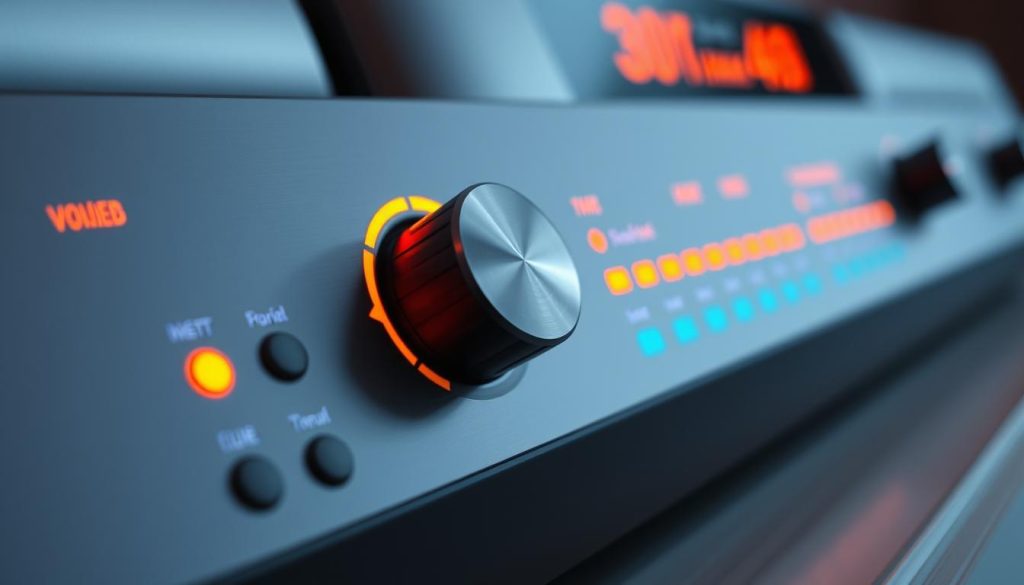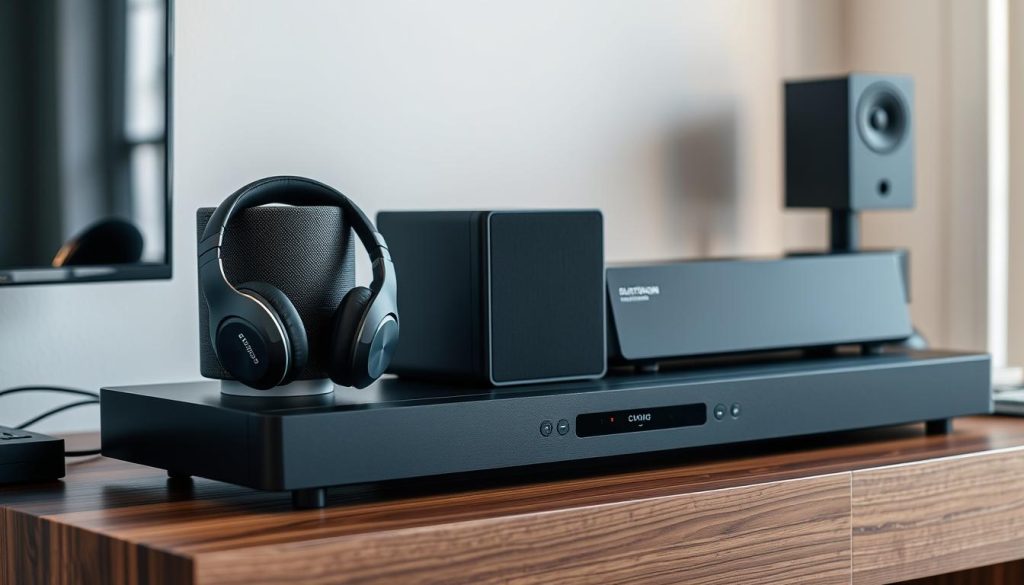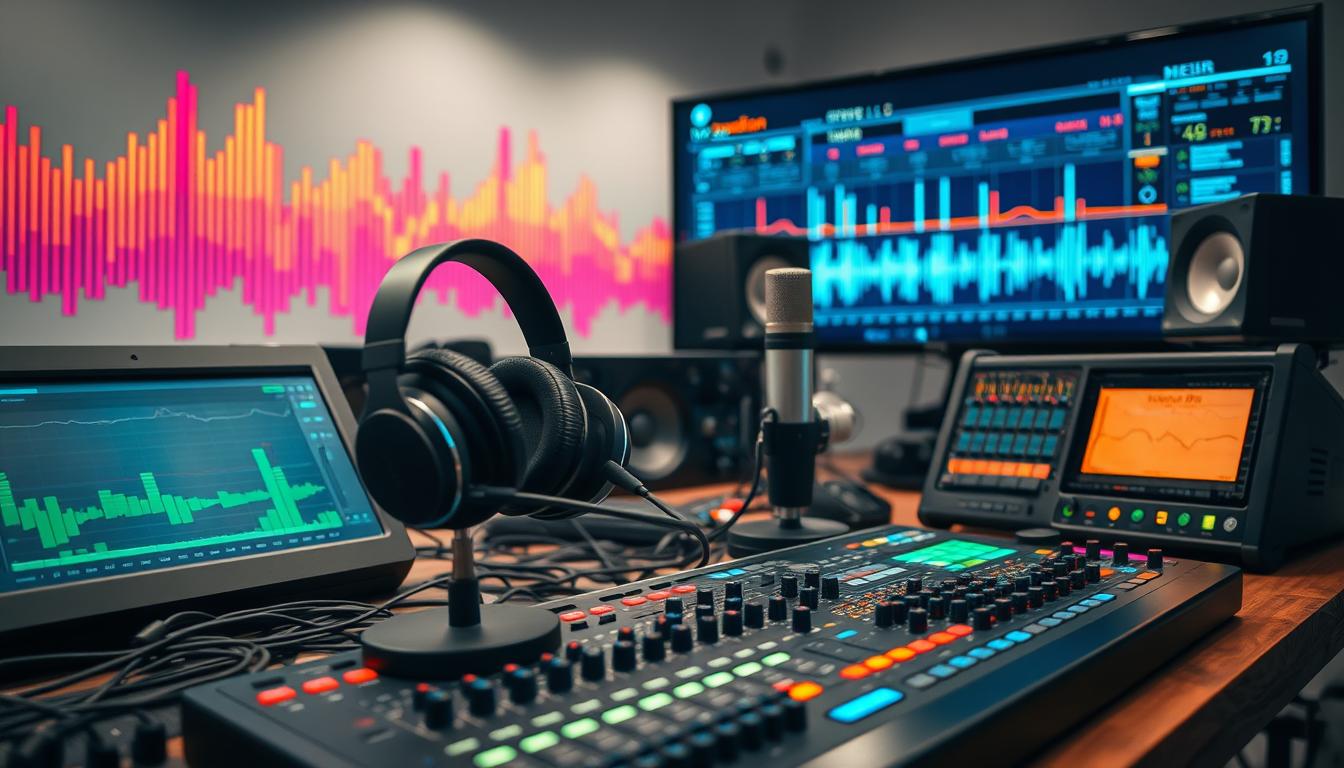Are you having trouble with your computer’s audio? Don’t worry, I’m here to help! This guide will show you how to fix your audio problems step by step. We’ll cover everything from using the Windows troubleshooter to updating drivers. You’ll learn how to solve common “no sound” issues on your Windows PC.
Sound problems can be frustrating, but they’re often easy to fix. Whether you’re facing no sound, distorted audio, or other issues, I’ll guide you to the solution. Let’s fix your sound problems together!
Utilize Windows Troubleshooter for Quick Fixes
If you’re having trouble with audio on your Windows PC, start with the built-in tools. The Windows audio troubleshooter is in the Get Help app. It can fix most common sound issues automatically.
Run the Automated Audio Diagnostics
The Get Help app’s audio troubleshooter makes fixing problems easy. It does a series of tests to find out why your audio isn’t working. Then, it fixes the issue for you. This tool saves you time and effort by doing the hard work.
- Open the Get Help app on your Windows device.
- Navigate to the audio troubleshooter and select “Run the troubleshooter.”
- The troubleshooter will automatically detect and diagnose any audio problems.
- Once the process is complete, it will provide you with recommended solutions to resolve the issues.
Using the Windows audio troubleshooter and the Get Help app helps you fix audio problems fast. You won’t need to do it yourself.
Reboot and Check Volume Levels

If the Windows troubleshooter doesn’t fix your audio problems, try restarting your computer. This can fix any temporary sound issues. After restarting, make sure your volume is turned up.
First, check your system volume. Right-click the speaker icon in the taskbar and choose “Open Volume Mixer”. Make sure the overall system volume is high enough. You can also change the volume for each program or app in the mixer if you need to.
- Reboot your computer to clear any temporary audio issues.
- Check the system volume by opening the Volume Mixer.
- Adjust the volume for any specific programs or apps as needed.
| Action | Description |
|---|---|
| Reboot computer | Rebooting your computer can often resolve temporary audio glitches. |
| Check volume levels | Ensure your system volume and any application-specific volumes are not muted or turned down too low. |
Rebooting your computer and checking your audio settings can fix many sound issues quickly. If problems don’t go away, you might need to check your audio device or update your drivers.
Verify Correct Audio Output Device

Windows might not send sound to the right speakers or headphones. To fix this, check your Windows sound settings. This ensures your system sends audio to the correct device.
Check Your Default Audio Output Device
To find the Sound settings, right-click the volume icon in your Windows taskbar. Then, select “Open Sound settings.” In the Sound Control Panel, go to the “Playback” tab.
Here, you’ll see a list of devices you can use for audio. Make sure the right device, like your speakers or headphones, is chosen and turned on as the default.
If the right device isn’t set as default, just click on it. Then, select “Set as default.” This makes sure all system audio goes to that device from now on.
Troubleshoot Audio Output Issues
- Make sure the audio output device is correctly connected. This could be wired speakers, headphones, or a Bluetooth connection.
- Check the volume of the selected audio output device. Adjust it if it’s too low.
- If you’ve changed your audio setup recently, try going back to the old setup. See if that fixes the problem.
By checking your default audio output device in Windows sound settings, you can quickly fix audio issues. This simple step often solves problems with no sound or audio not playing through the right speakers or headphones.
| Action | Steps |
|---|---|
| Check Default Audio Output Device |
|
| Troubleshoot Audio Output Issues |
|
Unplug and Reconnect Audio Cables
If you’re still having audio issues, check the connections of your speakers, headphones, or other audio gear. Loose or wrong connections can cause sound problems, especially with 3.5mm or USB cables. Let’s see how to fix this.
Firmly Seat Audio Cables
Begin by making sure all audio cables are fully plugged in at both ends. Even a tiny bit of looseness can mess up the audio signal. This might lead to crackling, static, or no sound at all. Push each cable connector fully into its slot for a secure fit.
Minimize Electromagnetic Interference
Watch out for electromagnetic interference (EMI) from nearby electronics. Devices like cell phones, laptops, or other gadgets can disturb the audio signal. Try moving these devices away from your audio setup to see if it helps.
By quickly checking your audio cable connections and reducing EMI, you can often fix audio problems easily. Remember these tips, and your sound quality should improve quickly.
Disable Audio Enhancements
Getting the best sound on your Windows device can be tricky. Disabling audio enhancements is a good first step. These features aim to improve sound but can sometimes cause problems.
Let’s look at how to turn off these enhancements in Windows audio settings. Here’s what to do:
- Open the Sound Control Panel by right-clicking the speaker icon in the taskbar and selecting “Open Sound settings”.
- In the Sound window, find your active audio device, right-click on it, and select “Properties”.
- Navigate to the “Enhancements” tab, and you should see a list of any audio enhancement features that are currently enabled.
- Carefully review the list and uncheck any enhancements you don’t need, such as “Bass Boost”, “Surround Sound”, or “Loudness Equalization”.
- Click “OK” to save the changes and exit the audio device properties window.
By turning off these audio enhancements, you’re going back to the default sound. This can fix problems with sound quality settings and Windows audio settings. This easy step can greatly improve your audio playback.
| Feature | Description | Recommended Action |
|---|---|---|
| Bass Boost | Enhances low-frequency audio for a more powerful sound. | Disable if you prefer a more balanced audio profile. |
| Surround Sound | Simulates a multi-channel audio experience on stereo speakers. | Disable if you have a standard 2-channel audio setup. |
| Loudness Equalization | Adjusts volume levels to maintain consistent loudness. | Disable if you prefer manual volume control. |
Update or Reinstall Audio Drivers
If your sound is still not working right, a missing or corrupted audio driver might be the issue. First, open the Device Manager and find the audio controller under “Sound, video and game controllers.” Right-click it and choose “Uninstall device.” After your computer restarts, Windows will automatically reinstall the driver.
If that doesn’t fix the problem, you’ll need to get the latest driver from the manufacturer’s website. Then, install it yourself.
Updating or reinstalling your audio drivers can fix sound issues. It’s easy to do and often the best fix when other steps don’t work. By keeping your audio drivers current, you can enjoy clear sound again.
It’s a good idea to check for and install driver updates regularly. This keeps your audio system running well. If you have sound trouble, updating or reinstalling your audio drivers might solve the problem.

